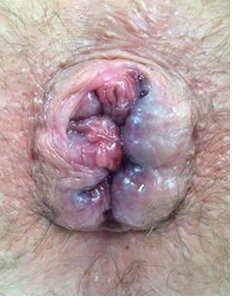What are Haemorrhoids?
Haemorrhoids are a common problem and affect up to 50% of people at some time in their life.
Haemorrhoids, also known as piles are rather like varicose veins in the canal of the anus.
Piles develop from three pads or cushions of tissue that line the anal canal or back passage. Here, just under the mucous membrane inner lining, is a considerable network of blood vessels extending upwards for an inch or so from the level of the skin to just above the anal canal, where it joins the rectum.
This tissue is normal – it acts as a compressible lining that allows the anus to close completely, so avoiding leakage. If the vascular cushions become dilated and swollen, they may then project into the anal canal and even out of the back passage (this is called prolapse) to form visible swellings. These swellings are the haemorrhoids ‘piles’.
A swelling protruding from the anus. Piles may be felt as small soft lumps at the opening of the back passage, sometimes compared to a ‘bunch of grapes’. They are usually soft and fleshy but may become hard if thrombosis occurs. The piles may only appear after straining at the toilet. Protruding haemorrhoids can lead to skin irritation and discomfort and there is usually mucus discharge from the irritated mucous membrane.

Bleeding from the back passage. The lining that covers the piles is quite delicate and if it is damaged, for example as you open your bowels, there may be bleeding which is usually seen as small amounts of bright red blood on the toilet paper or on the surface of the motions. Occasionally piles cause severe bleeding.
Mucus discharge and itching. Piles can cause intense itching of the skin around the back passage. Haemorrhoids can become inflamed and swollen, but are rarely very painful, unless associated with an actual splitting of the anus (anal fissure).
.
there are many new and modern operative techniques to eradicate haemorrhoidal disease
